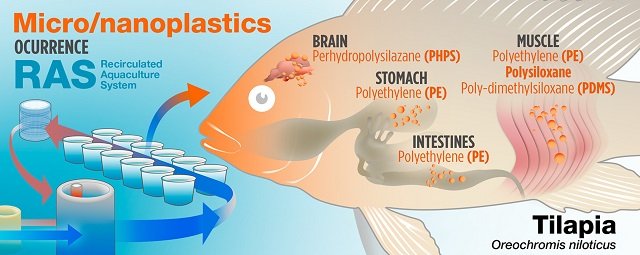
In an increasingly plastic-polluted world, the presence of micro- and nanoplastics (MPNs) in our food has become a topic of significant concern.
These particles, measuring less than 5 mm and 1 µm, respectively, constitute a substantial portion of global plastic pollution. They are found in both natural and urban environments, yet their presence in recirculated aquaculture systems (RAS) has received limited attention until now.
Researchers from the Universitat Autònoma de Barcelona, the University of Ferrara, the Institute of Environmental Assessment and Water Research (IDAEA-CSIC), and the Institute of Marine Sciences (ICM-CSIC) have recently published a study investigating the presence of MPNs in a European RAS facility that breeds Nile tilapia (Oreochromis niloticus) and its implications for food safety.
The Study
The study focused on a commercial RAS facility in Europe and aimed to identify the polymers present in both the system’s water and various fish tissues (brain, liver, intestine, stomach, muscles, and gonads) and quantify their concentration.
Researchers utilized advanced techniques, such as size-exclusion chromatography coupled with high-resolution mass spectrometry equipped with an atmospheric photoionization source, to identify five distinct polymers: polyethylene (PE), polyisoprene (PI), polysiloxane, perhydropolysilazane (PHPS), and polydimethylsiloxane (PDMS).
Impressive Findings
The analysis revealed that fish tissues retained varying quantities of these polymers. Muscular tissue contained the highest number of polymers, followed by the gastrointestinal tract, brain, stomach, liver, and gonads. Notably, neither the liver nor the gonads contained MPNs particles, while muscular tissue contained up to three distinct compounds. These findings suggest that MPNs are incorporated into fish tissues differently depending on the type of polymer and its specific properties.
Additionally, researchers discovered that two of the polymers were present in the system’s water, with significantly higher concentrations of PI in the effluent compared to the influent.
Implications for Food Safety
In teleost fish, microplastics can be absorbed through the gastrointestinal tract, gills, skin, and their absorption route can influence the retention and accumulation sites within the organism.
The presence of MPNs in fish muscular tissues represents an additional pathway of exposure for humans, as consumers may ingest fish contaminated with these particles. This finding adds to the growing list of pathways for MPN exposure.
Conclusion
“A total of five different polymers were detected in the analyzed samples, in six tilapia organs (liver, intestine, stomach, gonads, brain, and muscles), and the water system,” conclude the researchers. Furthermore, the muscle tissue of tilapia accumulated three of the five different polymers studied.
The study underscores the importance of investigating how MPNs enter RAS facilities, potentially through the degradation of plastic components, and assessing non-plastic alternatives (such as natural biofilters). It is also crucial to develop techniques to remove MPNs from these systems to minimize their presence and reduce their impact on global food safety.
In summary, the presence of MPNs and NPNs in recirculated aquaculture systems raises significant concerns about food safety and environmental health. Addressing this issue will require coordinated efforts to better understand their entry into aquaculture environments, explore sustainable alternatives, and develop effective methods for their removal.
The study has been funded by the European Union’s Horizon 2020 research and innovation program.
Reference (Open Access)
M. Blonç, F. Husson, M. Llorca, M. Farré, L. Tort, I. Brandts, M. Teles. 2023. Occurrence of micro- and nanoplastics in a commercial recirculated aquaculture system and their translocation to cultured fish organs: A baseline study, Journal of Hazardous Materials Advances, Volume 12, 2023, 100381, ISSN 2772-4166,
https://doi.org/10.1016/j.hazadv.2023.100381.
Editor at the digital magazine AquaHoy. He holds a degree in Aquaculture Biology from the National University of Santa (UNS) and a Master’s degree in Science and Innovation Management from the Polytechnic University of Valencia, with postgraduate diplomas in Business Innovation and Innovation Management. He possesses extensive experience in the aquaculture and fisheries sector, having led the Fisheries Innovation Unit of the National Program for Innovation in Fisheries and Aquaculture (PNIPA). He has served as a senior consultant in technology watch, an innovation project formulator and advisor, and a lecturer at UNS. He is a member of the Peruvian College of Biologists and was recognized by the World Aquaculture Society (WAS) in 2016 for his contribution to aquaculture.
